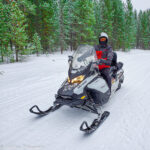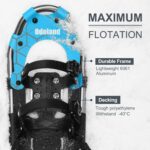Ever thought about combining your love for snowmobiling with the exhilarating rush of water sports? In this article, we are going to guide you on how to take your snowmobile for a spin… on water! Changing your terrain from snow to water might sound like a crazy, almost impossible concept, but with the right preparation and technique, you’ll be making waves in no time. Set aside all your doubts because once you master this technique, you’ll end up asking yourself why you didn’t try it sooner. This isn’t a typical snowmobiling scenario, but rather a thrilling experience you don’t want to miss out on!
Understanding Snowmobile Hydrosurfing
When winter sports meet summer fun, you get snowmobile hydrosurfing!
Definition of snowmobile hydrosurfing
Snowmobile hydrosurfing, also known as “water skipping” or “pond skipping”, is the exciting activity of riding a snowmobile across a body of water. It’s like converting your snowmobile into a jet-ski, but with the fearless exhilaration of speed and balance stylizing the whole experience.
The physics behind snowmobile water crossing
How does a hefty snowmobile stay afloat? It’s all about physics. Speed, surface tension, and the wide-ski design of the snowmobile keep it skimming across water. Essentially, the snowmobile needs to maintain a high enough velocity to generate sufficient lift to counteract the force of gravity. If it slows down too much, it sinks.
Essential Preparations Before Hydrosurfing
Preparation is key to a successful hydrosurfing experience.
Conducting proper snowmobile checks
Before you hit the lake, your snowmobile needs a thorough checkup. The fluids should be full, and belts tightened and tuned. The chassis should be free from damage and the throttle response brisk.
Choosing the right outfit
In line with general water sports protocol, your outfit should be protective, weather-appropriate, and buoyant. This can supplement your survival time in the water in case of a fall.
Understanding weather and water conditions
Clear weather is desirable for visibility and safe driving conditions. The water body you choose should be calm, deep enough, and preferably free of obstacles and underwater vegetation that could entangle the snowmobile.
Suiting Up for Safety
Safety can’t be overstated when hydrosurfing.
Importance of wearing a life jacket
Even if you are an Olympic swimmer, wearing a life jacket is non-negotiable. It adds buoyancy and improves your chances of survival if you fall into the water.
Sealing and protecting your body with a wet or dry suit
A wet or dry suit is recommended for protection against the water’s chill and any potential injuries during a fall.
Choosing water-resistant gloves and boots
Your extremities might get cold quickly, so invest in water-resistant gloves and boots to keep them warm and reduce the risk of hypothermia.
Helmet and goggles requirement
A helmet can protect your head from injury, while goggles will shield your eyes from spray, helping to maintain visibility.
Modifying Your Snowmobile for Water
Before taking the plunge, some changes to your snowmobile are necessary.
Installing a snorkel kit
This redirects the exhaust and intake higher up on the machine, ensuring your engine continues to breathe, even if the body of the snowmobile is partially submerged.
Sealing areas of possible water entry
Double-check that areas like the airbox and hood are sealed off to prevent water invasion.
Function and installation of a clutch kit
A performance clutch kit can help the snowmobile transfer power more effectively, making it easier to hydroplane across water.
Boosting the RPM and why it’s important
Higher RPMs equate to more speed, crucial for the momentum needed to keep your snowmobile skimming across the water surface.
Choosing the Perfect Location for Hydrosurfing
Finding the right spot is vital.
Criteria for a perfect hydrosurfing location
The best spots provide ample run-off space, deep enough water bodies, and are void of obstacles on the water and on shore, including other water users.
Identifying potential hazards in your chosen location
Avoid areas with rocks, logs, and other obstructions, and of course other people. Also, scope for too shallow water and muddy patches.
Considerations for easy access and emergency situations
Choose a spot that has easy access for you, and if needed, for emergency services. A mishap is the last thing you’d want, but it’s better to be prepared.
The Techniques of Acceleration
Your acceleration technique is crucial to successful hydrosurfing.
The role of acceleration in snowmobile water crossing
You need to hit the water at a high enough speed to ensure your snowmobile stays afloat, and continuously generate the speed throughout the course.
Perfecting your start technique
Begin by accelerating on land before you reach the water. This gives you a head start on building momentum.
Maintaining speed and judgment while on water
You need to have good throttle control to maintain speed without overdoing it. Practice and experience are key here.
Mastering Steering and Control
Steering a snowmobile on water is a unique experience.
The uniqueness of steering a snowmobile on water
Steering on water is different than on snow. On water, the machine tends to go straight, irrespective of the handlebar direction, unless you lean.
How to maintain control when on water
Using your body weight to lean into turns can help guide your path. And remember, do not abruptly let off the throttle; this can cause the snowmobile to sink.
Reacting to changes in water conditions and snowmobile performance
Stay alert to changes in the water, like waves or wind, and adjust your speed and direction accordingly. Similarly, if your snowmobile is behaving oddly, it’s best to head back to the shore.
Coming Back to Shore
The ride doesn’t end till you’re safely back on solid ground.
How to approach the shore safely
Ideally, you should approach at an angle rather than head-on, and gradually decelerate as you reach the shore.
Deceleration techniques
Decelerating gradually helps maintain stability and control. Rapid deceleration may result in your sled nose diving forward or even flipping over.
Assessing and avoiding shoreline obstacles
Keep an eye out for any immediate obstacles on the shoreline. Experience and proper judgment can help you safely navigate back onto land.
Care for Your Snowmobile Post Hydrosurfing
Your snowmobile needs attention after your exciting ride.
Cleaning and draining your snowmobile
A low-pressure rinse can clear out any muck and debris. Meticulously check and drain any water that may have entered the exhaust or air intake system.
Identifying and addressing any damages
Inspect your snowmobile thoroughly for any damage. If found, seek professional help to get it fixed.
Proper storage and maintenance post hydrosurfing
Dry the snowmobile completely before storage. Regular maintenance helps keep your sled in optimum condition.
Common Mistakes and How to Avoid Them
Avoid these common pitfalls to ensure a safer and more enjoyable hydrosurfing experience.
Underestimating the power of water
Respect the water. Things can go wrong, so wear safety gear, keep speed in check, and ensure you’re physically and mentally prepared.
Neglecting safety measures
Skipping on safety is a big no. Always wear a life jacket, helmet, and other safety gear.
Ignoring regular maintenance of your snowmobile
Failing to maintain your snowmobile can impact its performance and longevity. A well-maintained snowmobile ensures a safe and successful ride.
Unpreparedness for emergency situations
You can never predict when things might go wrong. Knowledge of basic first-aid and rescue processes, along with having emergency contact numbers handy, is advisable.
Snowmobile hydrosurfing is an exhilarating sport that combines the thrill of snowmobiling with the fun of water sports. With the right preparation, safety measures, and skills, you can have an unforgettable experience.
- What Snowboard Bindings Should I Get? - January 23, 2024
- What Size Screws For Snowboard Bindings? - January 23, 2024
- How To Snowmobile On Water? - January 23, 2024










